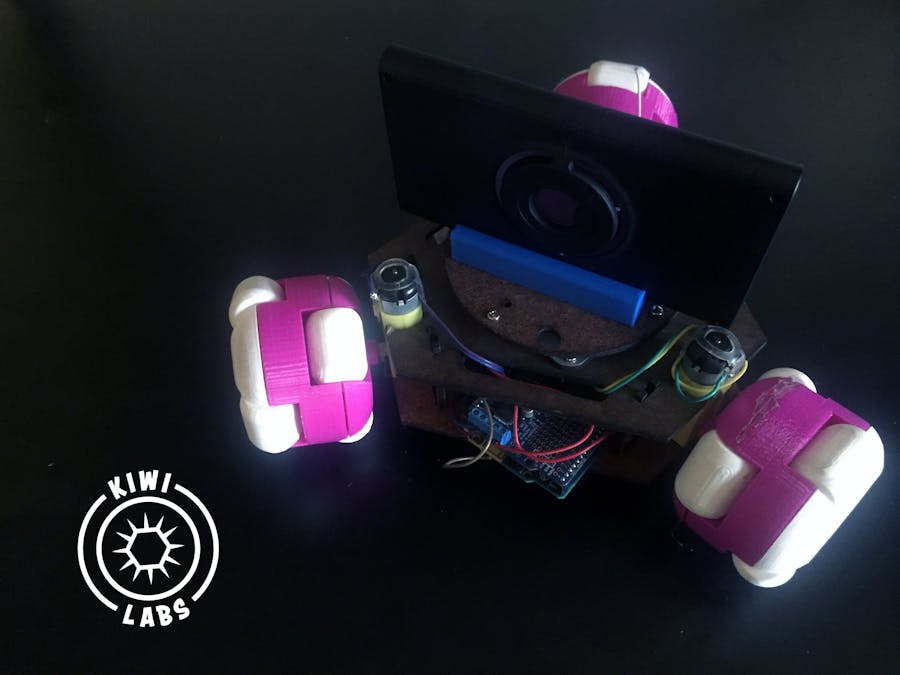This project is intended as a robotics kit for developing an omni-wheel driven kiwi drive robot. Electronics guides will come soon for Raspberry Pi, ESP32, and the PyCom. Currently, I have a NodeJS example on GitHub for using it with Johnny-Five via BLE firmata. I want people to pick their board of choice but still have a similar coding experience.
The full realization of this project will be when I am able to host a free workshop for 20 kids and get them from start to end, building and programming, in under 2 hours. I will then take that format and provide it as a resource for anyone else who would like to host a workshop. We've had success running numerous workshops like this in the past with 2 wheeled kits made from off-the-shelf parts for International Nodebots day.
Okay hold up, explain please!Whoa! What the heck is an omnibot? What in the world are these wacky omni-wheels you speak of? How come I haven't seen these in stores!?
Omni-wheels are basically wheels with rollers around them in a perpendicular configuration. This way when other wheels in the configuration are moving in a different direction, the inactive wheels turn into casters. By running the motors in a variety of combinations using MATH and SORCERY the robot can drive in all directions.
The above image kind of gives you an idea of the kinematic setup. In the nodeJS example I have on github, I do a little bit of math to show how to calculate vectors by converting cartesian to polar and then use those vectors to calculate the required speed of each motor. Then I drive the motors accordingly.
MAKE has an article that was helpful in figuring out the math.
https://makezine.com/projects/make-40/kiwi/
Why though?I've always been a huge fan of omni-wheels. Regular wheels are so boring. Omni-wheels make it easier to steer and easier to make autonomous robots that don't get stuck. There just aren't any low-cost kits. They tend to range in the hundreds $$. Every year we run nodebots day workshops and use low-cost kits so that every student can keep it at the end. The purpose of this project is to bring that cost down so we can get more people playing with and developing robotics projects using omni-directional drive. This will help kids learn why math is important in robotics in a fun way that provides observable physical application. This often ensures the student carries a continued interest in robotics. It worked on me.
3D-printed wheels?!This project started after I really needed omni-wheels and they were expensive and none fit the motors I was using. All the other printable omni-wheels required me to buy a ton of screws and bearings, which just means spending money and having to be patient.
So I designed the wheel (shown above) to require zero hardware. All you need is a 3D printer and some glue. So basically, this all started because I was annoyed.
https://www.thingiverse.com/thing:2553533
Lasercut Chassis?!3D printing the wheels made sense, fiscally, and because I wasn't about to mill them. The chassis needed to be cost-effective and easy to assemble as well. I was inspired by the PeeWee rover kits. They mount the motors using a notch and press-fit. I designed it in Autodesk Fusion360. Its all laser cut. So visit your local hackerspace!
You can optionally install a servo-driven platform. Just purchase a 3in diameter lazy susan from McMaster Carr and a standard 9g Micro servo.
All the files are here https://www.thingiverse.com/thing:2555667
What's next?!As stated, the next step is refining the software experience and experimenting with different hardware platforms. I want omnibots to be more common, its still surprising that the options out there are so sparse. The robot kits available at a fair price point are great but are essentially RC cars. We live in the future, lets update robotics education platforms to reflect that.
Once I develop a number of example projects and an experience that is palatable for the ages of 7 and up, I will gather the funding to host a workshop that hopefully inspires others to build and share these kits.









Comments
Please log in or sign up to comment.